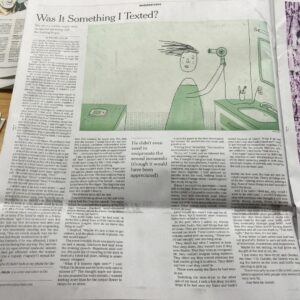The Harmful Impacts of Mental Illness Representation in Television

“A.D.A. Casey Novak: How can she be reading the paper as if nothing happened?
Dr. George Huang: Because she has a borderline personality disorder. She compartmentalizes the world, she’s always right and anyone who challenges her is not only wrong but her enemy.
A.D.A. Casey Novak: Including her children.
Dr. George Huang: Absolutely. Adam always obeyed her and so he was good. Jacob didn’t, so that made him bad.
A.D.A. Casey Novak: So she doesn’t really love them?
Dr. George Huang: It’s a twisted, narcissistic kind of love.”
If you watched this episode of Law and Order: SVU as a teenager, how would you perceive this depiction of mental illness? Without any supplemental education or fact-checking about Borderline Personality Disorder (BPD), it’s not hard to imagine that most people would take this at face value.
Television and stereotypes
Unfortunately, representations of mental illness in television, specifically illnesses other than depression and anxiety, are plagued by stereotypes that perpetuate stigma. By spreading misinformation, media portrayals of mental illness contribute to the social “othering” of people experiencing them. This dissonance between lived experiences and TV exacerbates associations between mental illness and negative stereotypes. As such, it’s problematic when TV shows imply a causal relationship between mental illness and criminal behaviour, even though people who experience mental illness are not at a higher risk of behaving in a violent or criminal manner than those without. These oversimplifications can be very harmful to people trying to understand themselves and the world around them.
By misrepresenting the experiences of individuals with mental disorders, beliefs about stereotypes may lead to a negative monolithic view of the community and subsequently perpetuate biases in public opinion. This has tangible consequences in interpersonal, emergency, or health-care responses to crises or episodes. For instance, statistics show that since 2015, almost a quarter of victims of police killings in the United States have been identified as having a known mental illness.
Mental illness is prevalent and important to normalize. John Hopkins Medicine estimates that about one in four adults in the US struggle with a mental disorder. Yet, despite the widespread nature of mental illness in society, there remains an ever-present educational gap between physical and mental health. When television depictions are someone’s only resource for understanding a mental disorder, it’s easy to imagine why stigma is still so pervasive. These negative, and sometimes completely incorrect, stereotypes make people with highly stigmatized and marginalized mental illnesses, such as BPD, Dissociative Identity Disorder (DID), Bipolar Disorder (BP), and Schizophrenia, seem menacing.
Law and Order: Special Victims Unit
While more inconspicuous shows that display mental illness can be equally detrimental, crime dramas are notorious places for associating criminals with mental illness. Law and Order: Special Victims Unit, for example, is packed with episodes pertaining to mental illness. The show is currently premiering its twenty-third season, bringing in over 9.2 million viewers. The extent of its social reach is cause for concern for the continuous negative representations of mental illness. The representations of these illnesses are particularly problematic because they highlight a dichotomy between the normalization of depression and anxiety in modern public discourses and the maintained fear of other mental illnesses.

Researchers in health communication argue that on-screen diagnoses are often “generic, vague and undefined.” The audience can then establish conjectures about people with these disorders simply because television uses the causal association between mental illness and crime as a tool for entertainment. Cluster B personality disorders, such as BPD, are characterized as having “dramatic, overly emotional, or unpredictable thinking or behaviour” and are thus often associated with instability and capacity for crime.
The earlier referenced example of BPD in Law and Order is a conversation in the episode “Home” between a fictional psychiatrist and lawyer discussing a woman who has been abusing her child. In another episode about a woman abusing a teenager, her psychiatrist ex-husband describes her as “a malignant narcissist, probably borderline.” In addition to this quote conflating Narcissistic Personality Disorder (NPD) with BPD, each example from the show ties abusive behaviour to mental illness, as if they go hand in hand.
The discussion highlights a broader problem with representation, linking negative stereotypes to disorders such as BPD that leave lasting impressions on audiences who may not be educated on the reality, spectrum, and nuances of living with mental illness. This, in turn, highlights the harmful effect of these misguided and inaccurate representations.
Reflections
Jamie*, a student who is a fan of Law and Order: SVU, and lives with BPD, explained their personal reflections on the portrayal of mental illness in the show: “After my diagnosis I started noticing the horrible and deterministic representation of BPD on TV. When I initially felt shame and fear that I was a bad person because of my disorder, I realized that I had been consuming this media for years that told me how people with BPD should be feared.”
They also found it concerning that the only depictions of BPD within the show contributed to stereotypes of manipulation and abuse. “Now I recognize that it feels dehumanizing to conflate these negative depictions with what the disorder is really like. There is, of course, a spectrum of living with BPD, where some people are more highly functioning and others experience increased destabilization in their everyday lives. Still, I have never wished to bring harm to other people. I struggle with emotional dysregulation, I’m not a threat to others. I have meaningful and healthy relationships, I have passions and hobbies, I’m just a person.”
Jamie emphasized how the stigma surrounding BPD prevents them from being open with others: “It’s also scary to think that people will watch someone with BPD on TV and assume that real people with the disorder could only act in those malicious, violent, and manipulative ways. That’s why I don’t tell many people about my diagnosis.”
Modern Love
Not all shows have this problem, though: some have successfully moved towards more accurate representations of mental illness. Amazon Prime Video’s adaption from the New York Times’ “Modern Love” column, for instance, has turned the stories of real people into visual media entertainment. Modern Love, the TV show, fosters a unique authenticity because of its faithful commitment to the testimonies of the stories.

“Take Me as I Am, Whoever I Am,” originally written as a Modern Love column by Terri Cheney, is an episode about Lexi, a woman with BP. The episode, albeit dramatized, is a realistic and nuanced portrayal of mental illness, showing how depressive episodes in particular have presented challenges and barriers to Lexi’s career expectations and romantic relationships. Rather than diminishing her identity and capabilities to these difficulties, the show also highlights her successes, the process of seeking support and treatment, and the importance of non-judgemental peers and friends.
Harmful depictions of mental illness can consequently lead to distorted perceptions of people who have these disorders in real life. This can also impact how people with mental illnesses view themselves and others, like Jamie. As such, the American Psychiatric Association cites that the stereotypes of prejudices of mental illness can have impacts on public, self, and institutional perceptions of the disorders. For example, public perception that “people with mental illness are dangerous, incompetent, to blame for their disorder, unpredictable”, results in discrimination from the job-market, systems of health-care, and social circles. These repercussions can also be internalized, where stigmas of mental illness on TV translate to negative self-esteem and a sense of unworthiness. People are less likely to seek help for mental illness when they feel shame and judgment.
Criminal associations and depictions can reinforce negative stereotypes and thus impact the social discourse surrounding mental illness. In order to move forward with the normalization of mental illnesses in addition to depression and anxiety, it is important for inclusions of mental illness in media to be facilitated by first-hand experiences. Furthermore, audiences must conscientiously engage with and criticize the negative stereotypes that can be made, and seek out the necessary nuance and education.
*”Jamie” is a pseudonym.
Edited by Savannah Sguigna.
Featured image: Episode of Law & Order: Special Victims Unit. “Mariska Hargitay and Danny Pino on the set of Law and Order: SVU, “Missing Pieces” Episode #13.5″ by Daniel P. Fleming on Wikimedia Commons is licensed under CC BY-SA 3.0.
